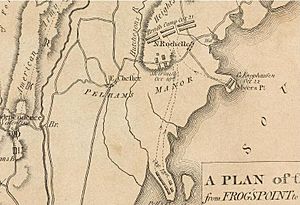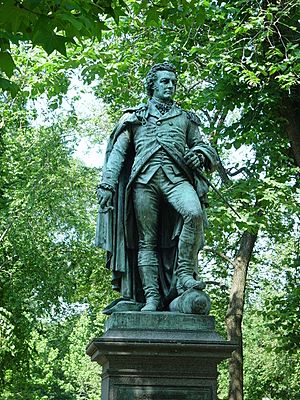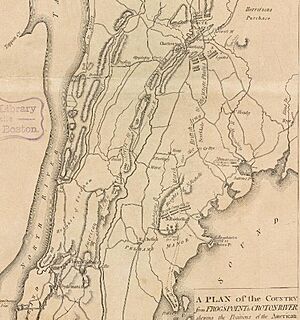Battle of Pell's Point facts for kids
Quick facts for kids Battle of Pell's Point |
|||||||
|---|---|---|---|---|---|---|---|
| Part of the American Revolutionary War | |||||||
 A period map of Pell's Point and the surrounding area. The Bronx was part of Westchester County at this time |
|||||||
|
|||||||
| Belligerents | |||||||
| Commanders and leaders | |||||||
| Strength | |||||||
| 750 | 4,000 | ||||||
| Casualties and losses | |||||||
| 8 killed 13 wounded |
3 British killed 20 British wounded 200–1,000 Hessian casualties (disputed - see Aftermath) |
||||||
The Battle of Pell's Point (also called the Battle of Pelham) happened on October 18, 1776. It was a small fight between British and American soldiers during the American Revolutionary War. This battle took place in what is now Pelham Bay Park in the Bronx, New York City, and nearby towns in Westchester County, New York.
On October 12, British forces tried to land at Throggs Neck to trap George Washington and his American army on Manhattan Island. The Americans stopped them. So, the British commander, Sir William Howe, looked for another place to land his troops.
On October 18, Howe landed 4,000 men at Pelham, a few miles north of Throgs Neck. Inland, about 750 American soldiers led by Colonel John Glover were waiting. Glover placed his troops behind stone walls and attacked the British. As the British moved forward, the Americans would fall back to the next wall and fight again. This went on for a while. The battle slowed the British down, which was important for the Americans.
The delay helped Washington move his main army to White Plains. This stopped the British from surrounding the Americans on Manhattan. After more battles, Washington's army moved across New Jersey to Pennsylvania.
Contents
Why the Battle Happened
The War in New York
After winning the Battle of Long Island in August 1776, the British commander, Sir William Howe, landed his troops at Kips Bay in Manhattan on September 15. George Washington and his army moved to Harlem Heights in northern Manhattan. This was a strong defensive spot, protected by rivers and rocky hills.
The next day, the British attacked but were defeated at the Battle of Harlem Heights. For about a month, both armies stayed in their positions. The Americans thought Howe might attack Fort Washington or try to go around their army by landing troops somewhere else. Washington decided to protect against both.
British Plan to Trap Washington
Howe decided not to attack Harlem Heights directly. Instead, he planned to go around the American army. On October 12, Howe took his main army in 80 ships up the East River and landed at Throggs Neck. This was a narrow piece of land between the East River and Long Island Sound.
Howe hoped to use a road from Throgs Neck to Kingsbridge. This road would let him get behind the American forces and trap them against the Hudson River.
American Defense at Throgs Neck
A group of 4,000 British soldiers landed first at Throgs Neck. But they found it was not a peninsula, but an island, separated from the mainland by a creek and a marsh. There were only two ways to get to the mainland: a bridge and a ford (a shallow crossing).
American soldiers, led by Colonel Edward Hand, were guarding both crossings. They had removed planks from the bridge and surprised the British. The Americans quickly got more soldiers, reaching over 1,800 defenders. Howe decided it was better to retreat and land somewhere else. He stayed at Throgs Neck for six days, waiting for more supplies and 7,000 Hessian soldiers.
Just after midnight on October 18, Howe's army got back on their ships. They decided to land at Pell's Point, a few miles north near the town of Pelham. Washington heard about the landing at Throgs Neck and knew his army was at risk of being trapped. He decided to move his army to White Plains for safety. By October 17, the Continental Army was on its way to White Plains.
The Battle of Pell's Point

At dawn on October 18, the British began landing on the shore. An advance group of 4,000 British and Hessian soldiers landed first. Facing them was an American brigade of about 750 men, led by Colonel John Glover. Glover saw the British ships from a hill.
Glover sent an officer to ask for orders from Charles Lee, Washington's second-in-command. But Lee gave no orders. So, Glover decided to attack on his own. He prepared his brigade, which included the 14th, 13th, 3rd, and 26th Continental Regiments. He kept 150 men of the 14th Continentals in reserve.
Glover's Ambush Strategy
Glover sent a small group of 40 men forward to hold the British back. Meanwhile, he set up an ambush. He placed his main force in a staggered line behind stone walls along the road from the beach. Glover told each regiment to hold their position as long as they could. Then, they were to fall back to the next wall, letting the next unit take over the fight.
The advance group and the British began fighting. Both sides had casualties. When the British got more soldiers, Glover ordered his advance group to retreat in an orderly way. The British then advanced on the retreating Americans.
However, 200 soldiers of the 13th Continentals were waiting behind a stone wall. When the British were only 30 yards away, the Americans stood up and fired. This ambush worked well. The British column suffered heavy losses and fell back to their main army.
British Attacks and American Retreat
The British waited for half an hour before attacking again. This time, all 4,000 men attacked, supported by seven cannons. They fired at the American position behind the stone wall as their soldiers moved forward. The cannon fire didn't do much damage. When the British were 50 yards away, the Americans fired a volley, stopping them.
Both sides fired their muskets and rifles for 20 minutes. The British had cannon support. Eventually, the American regiment at the front fell back, letting the next reserve regiment take its place. The 3rd Continental Regiment was behind a stone wall on the other side of the road.
The British attacked the 3rd Continentals. Both sides kept firing constantly. The Americans broke the British lines several times. But after 17 volleys, the British numbers started to overwhelm the Americans. Glover ordered another withdrawal to a stone wall on top of a hill. The 26th Continentals then engaged the British.
A small group of 30 American soldiers went out to see if the British would try to go around their position. They ran into the British, who were still advancing, and fell back to the stone wall. The Americans behind the wall fired one volley before Glover ordered a full retreat. The Americans crossed a bridge over the Hutchinson stream. The 150 men of the 14th Continentals covered their retreat, fighting an artillery duel with the British. Howe camped on a hill on the other side of the stream but did not try to cross it.
What Happened Next
The day after the battle, Glover and his soldiers retreated to Yonkers. The Americans had 8 soldiers killed and 13 wounded. The exact number of British and Hessian casualties is not known. Howe's official report said 3 British were killed and 20 wounded, but it didn't include Hessian losses. Since Hessians made up most of the landing force, they likely had many casualties.
Some American estimates, based on British deserters, claimed the British lost between 800 and 1,000 killed or wounded. This was probably an exaggeration. Colonel Loammi Baldwin, who was at the battle, estimated 200 British and Hessians were killed. Historians believe the combined British and Hessian casualties were almost certainly more than the Americans'.
The Battle of Pell's Point delayed the British advance. This allowed Washington's main American army to safely move from Harlem (Manhattan) to White Plains. Howe slowly moved his army through New Rochelle and Scarsdale. On October 28, he sent 13,000 men to attack the Americans, winning the Battle of White Plains.
Fort Washington, the last American stronghold on Manhattan, fell on November 16. After these defeats, Washington and his army retreated across New Jersey into Pennsylvania. This set the stage for the important Battles of Trenton and Princeton.


